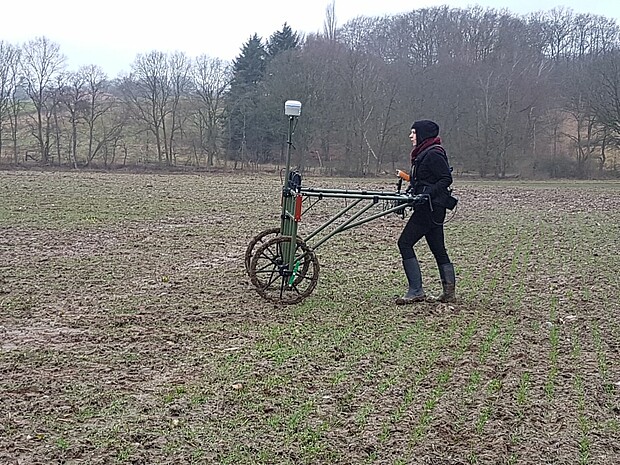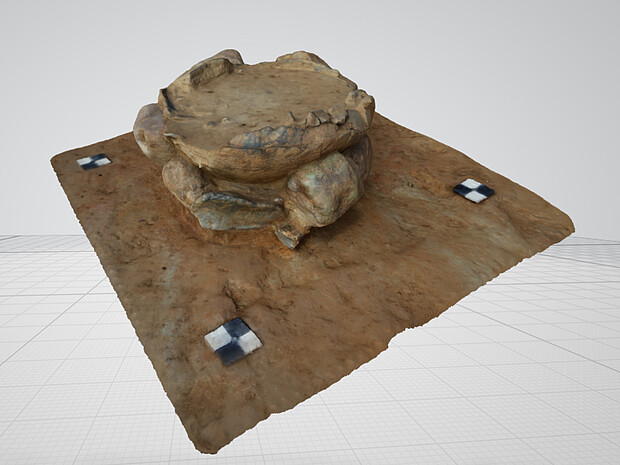Rituals in a new light – Modern field research, documentation and visualisation strategies using the example of the burial ground of Nienbüttel


As part of the project funded by the state of Lower Saxony through the Pro*Niedersachsen programme, the NIhK (Dr. Melanie Augstein, Christina Peek M. A., Pière Leon Frederiks M. Sc., Dr. Katrin Struckmeyer) together with the Chair of Pre- and Protohistory at the Heinrich Schliemann Institute of Rostock University (Prof. Dr. Hans-Jörg Karlsen), the State Academy of Fine Arts Stuttgart (Dr. Andrea Fischer) and the Department of Prehistoric Anthropology and Human Ecology of Göttingen University (Dr. Birgit Großkopf) is conducting new research on the large urnfield of Nienbüttel (district of Uelzen).
In Nienbüttel excavations took place as early as the beginning of the 20th century, of which those conducted by Gustav Schwantes are particularly noteworthy, as Schwantes documented the archaeological record in great detail and according to scientific criteria for a layman, which he still was at that time. Nienbüttel would perhaps have become the paradigm of a weapon-furnished burial ground in the Lower Elbe region if it had not experienced such a changeful and in many respects unfortunate ›biography‹. As part of a project funded by the DFG from 2014-2020, the old excavations were reappraised critically by Dr. Melanie Augstein and Prof. Dr. Hans-Jörg Karlsen and the grave inventories were reconstructed as far as possible. Initial small-scale field research by the Universities of Leipzig and Rostock has shown that a large part of the cemetery has not yet been excavated and, above all, that there are still undisturbed areas where intact urns, depositions of objects without a grave context and enigmatic large concentrations of stones can be found. It is evident that Nienbüttel was more than just a place where urns were deposited.
This is where the new project starts. Through the combined use of geophysical measurements, 3D structure-from-motion technology, soil analyses and small-scale archaeological field work in which complex structures are recovered in block excavations and examined under laboratory conditions using fine stratigraphy and textile analysis, the aim is to reconstruct the sequences of the burial ritual and the complex ritual events that took place in the cemetery area.
References
Augstein, M. und Karlsen H.-J., 2016: Nienbüttel – der »reichste Urnenfriedhof des östlichen Hannovers«. In: A. Siegmüller, Ch. Peek, B. Ludowici u. H. Jöns (Hrsg.), Aktuelle Forschungen an Gräberfeldern des 1. Jahrtausends n. Chr. Siedlungs- und Küstenforschung im südlichen Nordseegebiet 39, 25–36. Rahden/Westf.
Augstein, M. und Karlsen, H.-J., 2019: Nienbüttel – New Research on Old Graves. In: M. Augstein u. M. Hardt (Hrsg.), Sächsische Leute und Länder – Benennung und Lokalisierung von Gruppenidentitäten im ersten Jahrtausend. Neue Studien zur Sachsenforschung 10, 227–235. Wendeburg u. Braunschweig.
Karlsen, H.-J. u. Augstein, M. 2023: Das Gräberfeld von Nienbüttel – der »reichste Urnenfriedhof des östlichen Hannovers«. Die Altgrabungen von 1901 bis 1911. Neue Studien zur Sachsenforschung 12. Wendeburg u. Braunschweig.
